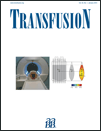Thawing of cryopreserved hematopoietic progenitor cells from apheresis with a new dry-warming device
Abstract
BACKGROUND: Current thawing techniques of cryopreserved progenitor cells are based on the use of a water bath. The aim of this study has been to assess the progenitor cell viability and the time of hematopoietic engraftment after transplantation of cell products thawed with a new dry-thawing device.
STUDY DESIGN AND METHODS: In the preclinical phase, two cryobags from the same patient were thawed with the standard technique and with the dry system method in parallel (n = 5, Protocol A and Protocol B, respectively). In the clinical phase, cryobags were thawed with the dry system and the time to hematopoietic engraftment after autologous transplantation (n = 52) was compared with those of a control group of patients whose progenitor cell products were thawed with the standard technique (n = 52).
RESULTS: There were no statistical differences in nuclear and CD34+ cell viability, total colony-forming cells, and cloning efficiency after thawing with Protocols A and B. Days to neutrophil (>0.5 × 109 and >1 × 109/L) and platelet engraftment (>20 × 109 and >50 × 109/L) were not different between patients transplanted with products thawed with Protocols A and B.
CONCLUSION: Progenitor cell viability and function are preserved with this dry-thawing system. The time to hematopoietic engraftment of patients after transplantation is comparable to those infused with progenitor cells thawed with the water bath technique. Thawing cell products without the use of water and in a dry environment might favor the use of this dry method.




